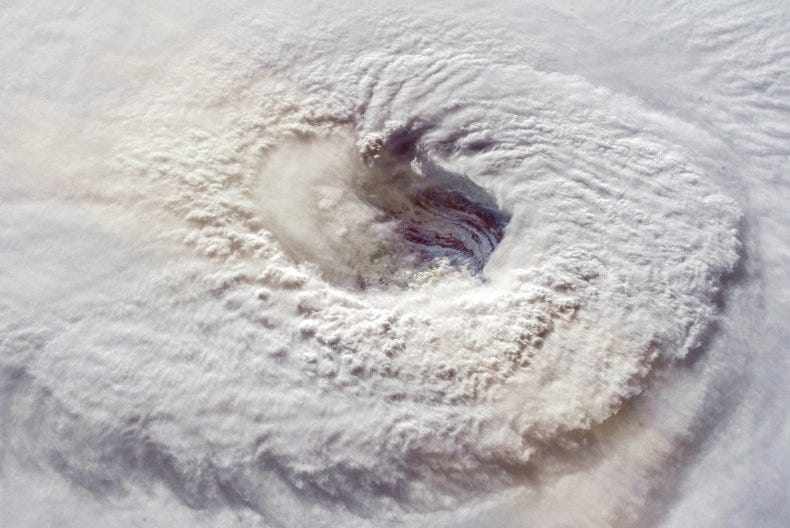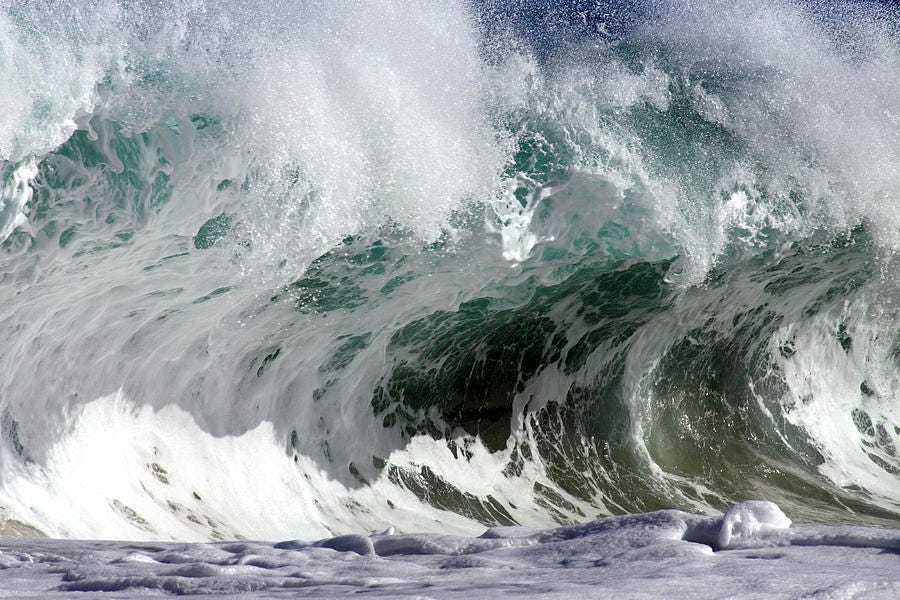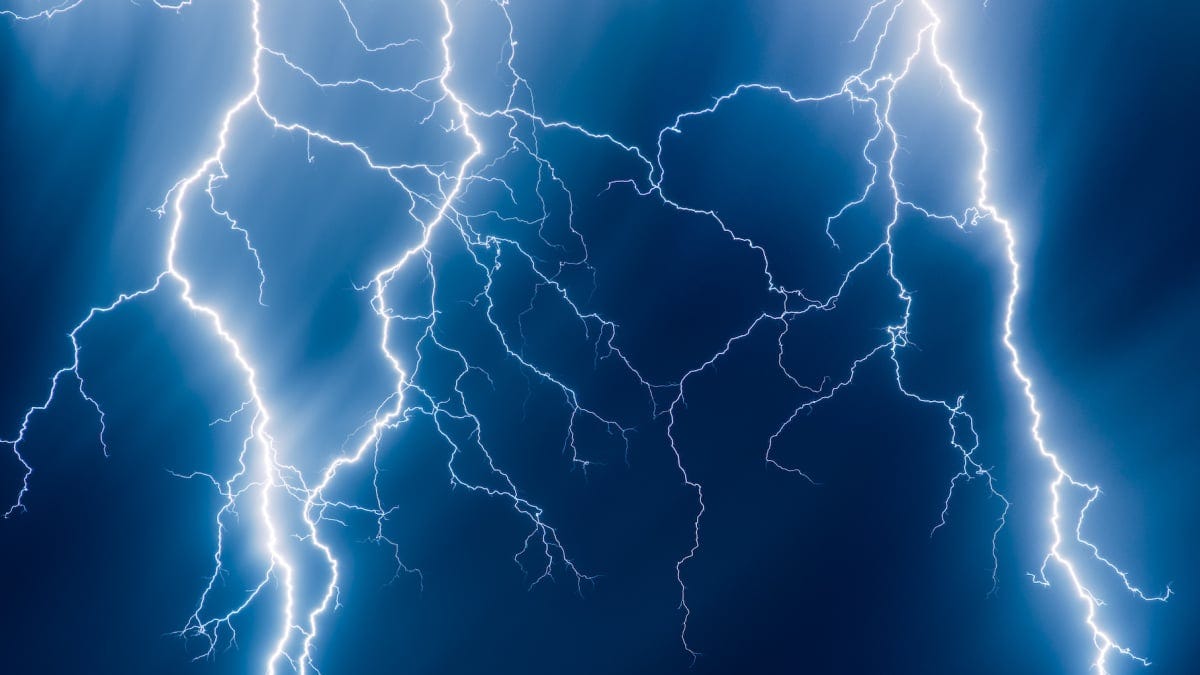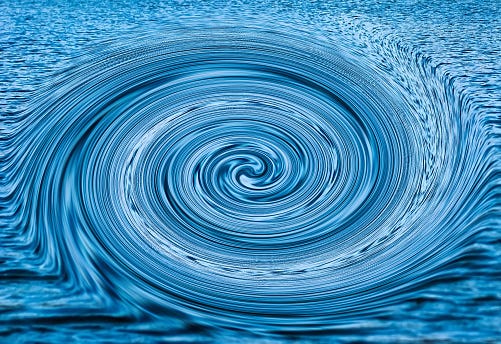Forever Thrilled, Part 15
Chapter 5: A Wave of Hypersea

Remembering how she lost four out of her five Kittis the previous time she explored this layer, Na-Yeli programs the new probes differently. Instead of sending them in all directions, she sets up a quick, vertical in-and-out. If there’s still a powerful vortex with hurricane-force winds, then hopefully, more than one will return.
That is, of course, if they enter into an atmosphere. More likely, they’ll end up at the bottom of a sea. However, that sea may also have a wild and turbulent flow that could disperse the probes. So, the same principle still applies: a quick in-and-out.
The probes all return in one piece. They’ve been in an atmosphere, not water, which surprises Na-Yeli. Where has all the water gone? She wonders, while being relieved they don’t have to build a pressure dome around the Diaphragm Gate, which would have been quite a challenge, indeed. She had already anticipated this a bit, designing a double dome where the pressure between the outer and the inner dome would be well below 0.25 bar—the pressure inside the A Wall of Tentacles layer—to keep them both propped up once they’ve used some considerable lifting rockets to get them there. Pressure pumps to increase the pressure in the inner dome, sacrificial labyrinth seal at the top of both domes (which would be mounted upside-down, as it were), building the lot in the temperate region and then transporting it to the South Pole. Engineering galore, fortunately, is not necessary this time, as the pressure the probes measured is about 1.5 bar, which should be no problem for Na-Yeli and the fully recovered Moiety Alien.
Furthermore, the atmosphere hasn’t changed much since their first passage, Na-Yeli sees as she checks the readings of her spectrometer. 96% N2 and 2% O2, the H2O vapor supersaturation has increased to 1.5%, with considerable amounts—around 0.2 to 0.3%—of both H2 and Cl2 gasses. Finally, traces of NO, NO2, H2O2, O3, and Na+, Cl-, H+ and O2- ions.
The camera shots show that there’s light, plenty of it. The reddish-tinted background illumination of the all-pervasive chemoluminescence in the air shot through with the occasional massive bolt of lightning. Like the previous time, they’ll be entering into a huge vortex, the eye—possibly—of a world-encompassing cyclone.
Their supplies have been replenished, their batteries are full, the Moiety Alien seems to have recovered entirely, and Na-Yeli is not exactly in the mood to witness another massacre. She switches on the communication AI and speeds up the hypersounder simulation so that communication becomes easier as their relative clock speeds match (admittedly, something the communication AI found out by trial and error).
“Wakey, wakey,” Na-Yeli says as the communication AI powers up, “time to go to the next layer.”
—did anything interesting happen in this one— the communication AI signals
“Not much,” Na-Yeli says with a weary voice, “the Moiety Alien recovered, I recovered—albeit much slower—we studied the local ecosystem and witnessed two massacres.”
—two massacres— the communication AI signals —sounds interesting enough to be activated for—
“Sorry, but I was too emotionally drained,” Na-Yeli says, “I’ll explain it someday.”
After the hypersounders are up to speed, Na-Yeli continues her executive summary, explaining that they’re about to enter what used to be the “A Sea of Hyperwaves” layer. Expressing surprise at not finding water at the bottom—where they enter the next layer—even if it will make their entry so much easier.
“I suppose we will find out as we make our crossing,” Na-Yeli finishes her summary, “and beware. While you ... ehrm ... intelligences ... entities ... well, people don’t directly experience sudden accelerations, decelerations and the forces of acrobatic turns, this may be a very wild ride. If it becomes too wild ...” Na-Yeli pauses for effect, “...then master pilot-cum-daredevil KillBitch will take over.”
“Everybody ready?”
—aye— the communication AI signals —and the hypersounders say ‘aye’ with a thousand echoes—
Na-Yeli sends a ‘ready?’ query to the Moiety Alien, who responds with a quick and vigorous nod. It looks good, she thinks, let’s go. They dive through the selectively permeable membrane, experience a slight anti-pop as the pressure increases, and need only minor countersteering against the prevailing clockwise winds, which are relatively weak.
The eyewall surrounding them, not so much.
Na-Yeli glides around in a holding pattern in the circular thermal, studying her environment. The sky is slightly red, lit up by massive lightning bolts all around them, their ghostly reflections highlighting the massive eyewall they find themselves in. Na-Yeli shoots a few laser measurements at the eye wall, determining its rotational speed at nearly twenty-five hundred kilometers per hour.
Mach two in this atmosphere, Na-Yeli thinks, insane. Only the rare superstorm on Neptune in her home system matches this, and since the eyewall runs from the bottom of the inner barrier—whose diaphragm they just passed—all the way to the top of the outer barrier, they have no choice but to cross it. I’ll have to figure out a way to accelerate us in steps, she thinks, because diving in straightaway would unleash G-forces not even her shock absorbers could dampen. She was slapped around badly enough when she entered on her way in—no Moiety Alien and hypersounders with her, then—and then the eye wall was ‘only’ moving with hurricane category 5 wind speeds. This is almost ten times faster.
While the air inside the eye wall is tinged red—the NO + O3 ⟶ NO2 + O3 chemiluminescence at work—the eye wall itself, the higher up she looks, is pinkish white. Clouds, Na-Yeli determines, we’re in the middle of the mother of all storms. It makes her wonder, and more than a little bit anxious, to find out what’s behind that eye wall.
Seeing all the lightning—which has been relentless since they entered—Na-Yeli strengthens the Faraday cage in her exoskin. She’ll try to avoid being struck by lightning, but if they’re hit, she wants to be prepared. She has no clue if the Moiety Alien can withstand a lightning strike and is at a loss to ask. Then she reminds herself that Moiety Aliens seemingly withstood laser fire, tactical nukes, and worse and that the extremely rare, hyper-dense strangelet debris is probably one of the very few materials that can actually hurt it. Compared to that, lightning is what? A tickle? A local goosebump? She figures it’ll let her know if it considers it dangerous.
Na-Yeli keeps spiraling upwards, as she prefers to cross the eyewall above the cloud level, hopefully to avoid the lightning. She goes higher and higher, yet there is no break in the cloud layer. The clouds either go all the way to the top, she thinks, or ... Or the centrifugal forces in this layer supersede the gravitational ones.
They’re getting close to the top. Na-Yeli could spiral down again to see if she’s overlooked something. But she doesn’t think so, and at some point, they’ve got to commit. Better high up than low down, she thinks, because if something goes wrong, I’ve got some time to think while we fall.
“OK, crew,” she announces, “we’re going in. It might get quite rough.”
—aye cap’n— the communication AI signals —on behalf of the hypersounders: what a great adventure—
An adventure? Na-Yeli thinks, I’m trying to get the most important information in the Universe—well, at least this Universe—out, and they think it’s an adventure?
She shakes off her vexation and prepares a small, scoop-like sail with some very strong yet very flexible ropes, superstrings if you like. With a Kitti, she moves the scoop sail close to the eyewall while following not far behind, using her ion thruster to increase her speed. She’s going close to two hundred kilometers per hour now, still twelve times as slow as the hyper-winds in the eyewall.
Through the Kitti, she pushes the scoop sail partly into the eyewall, which tows it along in a flash, immediately tightening the superstrings running from the scoop sail to Na-Yeli. She feels a very sharp tug for a short while as the safety opens. She’s set the pull safety to about 10 G, something she and her equipment should be able to withstand while taking on the most aerodynamic shape possible. They’ve sped up to four hundred kilometers per hour but are slowing down again.
A quick reconnect of Na-Yeli with the scoop sail followed by a quick connect of the scoop sail with the mega-cyclone’s eye wall, another short and very sharp tug until the safety opens. Repeat. Rinse & Repeat. Repeat almost ad infinitum as their speed increases close to Mach 1. Every further tug increases the speed less due to the smaller speed difference and the increasing drag Na-Yeli—despite her ultra-sleek form—is experiencing.
It takes twice as long to get from Mach 1 to Mach 2 as it took them to get to Mach 1. The area of diminishing returns. On top of that, Na-Yeli’s bow is slowly getting hot to the point of overheating as she sees the world racing by at a crazy speed. Counter-intuitively, a blunt shape functions better as a heat shield—as the historical records of the first space shuttles show—but that will wreak havoc with her aerodynamic shape. Hence, she’ll have to deal with temporary overheating as she approaches Mach 2. Twisting her wings, torquing the ion thruster with all her might while setting all shock absorbers to maximum, she dives into the eyewall.
She’s hurtled around, turned over, slammed sideways, and swept around like a brown leaf in an autumn storm. Make that a fall hurricane. A category 5, at that.
She’s experiencing G-forces like never before—the massive slap of the golden tentacle in the previous layer the only possible exemption. Typically, it hurts less because she’s prepared (and because her shock absorbers were off when the Wall of Tentacles struck her down). Not that it’s nice, all of a sudden, more like ... survivable.
As she overcomes the initial pain, she concentrates on stabilizing—better, regaining—her flight. Well, what they’re doing now is just being swept along like debris in a tropical cyclone. Uncontrolled, they might slam into anything. She needs to regain control.
So she’s flapping her wings, winging her stabilizers, stabilizing her flaps. As a trained pilot, she knows what to do but finds that she’s just too slow. Thus, like the purposefully unstable fighter planes of yore (so that their turnaround radius was smaller than that of enemy aircraft), she must let the autopilot do that.
Somewhere in the back of her head, KillBitch snarls: go away, let me show you. But Na-Yeli, the slow CEO, holds her back. You’re here for true emergencies, the slow CEO commands, not for normal flight. For your measure of ‘normal flight,’ obviously.
Furthermore, Na-Yeli’s outer cameras don’t have much vision. They’re in the middle of the clouds, being tossed around by turbulence so fierce it makes the turmoil they experienced in the Doom Bell Hell inferno seem like amateur hour at the bungee jump club.
On top of that, they’re very close to the lightning, or better, very close to where it originates. As far as Na-Yeli can discern, while she’s being tossed through the tempest like a bat into hell, the lightning doesn’t go downwards as on Earth, like from the clouds to the ground. In here, it seems to go sideways, making it all the more difficult to avoid. Nevertheless, she needs to stabilize their flight first.
The autopilot takes over and runs through its stabilizing algorithms as it speeds up to the required rate. Na-Yeli’s wings, stabilizers, and flaps move like crazy in a rhythm she cannot follow, yet their flight evens out. They’re moving almost twenty-five hundred kilometers per hour in the biggest storm she’s ever experienced. If she wasn’t so focused on getting out of this Enigmatic Object, she might almost call it an adventure.
—supercool— the communication AI signals —the hypersounders say. can we do it again—
“Not so fast, crew,” Na-Yeli says as she rolls her eyes, “there’s another one of us out there.”
Na-Yeli scans the super-stormy skies, more by radar than by line-of-sight, and, to her utter surprise—and delight—the Moiety Alien is following her, seemingly with ease. Its orbitals shrink and expand with an incredible speed, also to a rhythm mere mortals can’t follow, as it stays close to Na-Yeli.
So far, so good, so fast. If we’re lucky, Na-Yeli thinks, We can speed to the North Pole like this and be out here in record time. Then—as they’re moving towards the bottom of the clouds, through the massive lightning strikes, torrential rains, and deafening thunder, she gets a glimpse of the next eyewall.
Well, it’s not really an eyewall but rather a massive wall of water. It’s quite far away, and the clouds they constantly move into, together with the monumental lightning bolts blinding her make it hard to estimate the distance. But it’s several kilometers, at least, maybe even more than ten. There’s the water, Na-Yeli thinks, and if it’s genuinely floor-to-ceiling, we have no choice but to dive in.
Slowly, step by step, Na-Yeli builds a picture of the workings of this layer. Both the seawater and the atmosphere are rotating like crazy. For the moment, she doesn’t exactly know why—even if she does have an inkling—but spin like a centrifuge they do.
Hence, centrifugal and centripetal forces are dominant, pushing the materials with the highest specific gravity outwards, towards the direction of the equator on the outer barrier. Hence, the inside of the eye wall of the atmospheric mega-cyclone—the eye of the superstorm—is ‘up.’ The top of the clouds touches the eyewall, meaning the cloud cover fully envelops the ‘top’ of the sky.
The clouds charge up through the same process as they do on Earth, possibly assisted by several chemical reactions she hasn’t fully discovered yet. Then the lightning strikes’ down’ towards the ocean: the direction is radial in this topsy-turvy world.
The ocean is rotating so fast that—like water in a fast-spinning bucket—it’s forced to the farthest radius. Meaning she can project the radius of the water wall—or the ocean gyre, the seawater maelstrom, well I can do better than that, wait, the superswirl—to the northern hemisphere of this layer, where it will encompass another mega-cyclone and another eye wall.
They have to go ‘down’ into the huge centrifugal sea—the hypersea, if you will—before they can go ‘up’ again (after crossing the equatorial currents, whose speeds will put many a white-water rafting current to utter shame). During the first passage, this was a Sea of Hyperwaves. Now, it is, indeed, a Wave of Hypersea.
Because the rotating speeds are so stupendously fast, and they have no choice but to ride them, this means that any radial and axial travel movements they make—and they have to make those if they wish to get to the North Pole of this layer—will effectively become a long, closely entwined spiral. Meaning it’ll be next to impossible to evade the lightning. This means it’ll be next to impossible to avoid any natural phenomena appearing in the hypersea, let alone any sea life (and Na-Yeli shudders when she remembers her fights with the stealth sharks).
Support this writer:
Like this post!
Re-stack it using the ♻️ button below!
Share this post on Substack and other social media sites:
Join my mailing list:
Author’s note: as Autumn is upon us, here in the Northern Hemisphere, it also coincides with the end of the hurricane season. I never planned that this part of “Forever Thrilled”, with its depiction of the mother of all huricanes, to be so soon after two major hurricanes hit the US Southeast. People, stay safe and I hope you got through them with limited damage.
Please keep in mind that this novel is a figment of my imagination and isn’t meant to resemble actual events. In order to fulfil my commitment to publish “Forever Thrilled” in full befor the end of the year, I must continue this serialisation. Many thanks for your understanding and reading!






